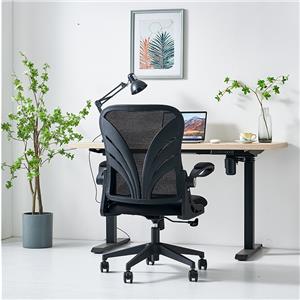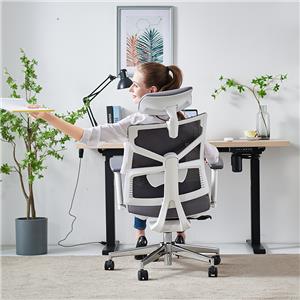Ergonomic chair goals
The ergonomic chair should have a basic goal from the beginning, which is to reduce the continuous stress on the waist and back muscles for people who sit and stand for long periods of time, maintain the normal S-shaped physiological curvature of the spine, and relieve the stress on the waist muscles. Strain prevents irreversible structural changes in the bones and intervertebral discs in the waist.
1. Maintaining the strength of the upper body balance is the key to waist fatigue.
Let’s talk about sitting posture first. We need to be clear, how do humans maintain an upright posture? It is obvious that people cannot maintain a sitting posture without consciousness. Maintaining a sitting posture, especially maintaining an upright state of the upper body, obviously requires the brain's fine dynamic adjustment through the muscles of the waist and back to enable humans to maintain the balance of sitting and standing. This is The maintenance of this balance does not require the participation of our subjective consciousness, but relies on very precise neural regulation and muscle memory. Just as you can observe that it takes nearly half a year for a newborn to learn to sit in this posture, you can imagine its inherent complexity.
However, the interpretation of the spinal force ratio table in the sitting posture that is often mentioned repeatedly is often not very accurate.
When sitting and leaning back, the spinal pressure is 75%, and when sitting and leaning forward, the spinal pressure is 180%. So sitting backward is less tiring than sitting forward and leaning forward?
Let’s analyze it carefully to see if this conclusion is correct. You can imagine sitting on a bench without a backrest. If you want to maintain a backward posture, it will not only be very difficult, but also easy to lose balance. This is because our abdominal muscles are not as strong as the lower back muscles. . When the chair back is supported when sitting back, the chair back bears part of the weight of the upper body, and the force required to maintain the balance of the upper body in the horizontal direction decreases as the angle increases. Therefore, the back support of the chair is the reason why reclining back is much easier and more comfortable. When in a tilted state, the psoas and abdominal muscles not only bear the weight of the upper body, but also resist the force of body imbalance. It was too difficult to think about not getting tired without support.
Let's think about it again: if you lean forward and your upper body can lie on a wooden board, then the wooden board can bear part of the weight of your upper body, and the force required to maintain the body's balance in the horizontal direction will become smaller as the angle becomes smaller. Next, if you sit in a reclined position without the support of the chair back, your psoas and abdominal muscles must maintain body balance and bear the weight of your upper body at the same time. The greater the recline angle, the more tiring you will be.
Therefore, the correct understanding is that with support, as the tilt angle of the spine increases, more gravity is distributed to the support. The smaller the force required to maintain the body's balance, the greater the weight ratio of the spine. Small. On the contrary, without support, the greater the inclination angle of the spine, the greater the force required to maintain body balance in addition to gravity, and the greater the force ratio of the spine.
To put it simply: if there is support to share the weight of the waist and abdominal muscles, you will not be so tired.
2. A better choice is to have the support point near the sacrum
It’s less tiring with support, so where is the better support point?
Some friends feel very tired in the waist because they sit for a long time. They feel very comfortable if they put something behind the waist. Therefore, it is easy to think that lumbar support is very important and the support point is behind the lumbar spine. In fact, the lumbar curve formed by the lumbar vertebrae has a lordotic physiological curve in the sagittal plane. If a lumbar pillow or cushion is added behind the lumbar vertebrae for support, the lumbar pillow or cushion is actually pushing the lumbar vertebrae forward.
This will bring about three problems:
1. An ill-fitting lumbar back pillow will affect the balance maintenance of the lumbar spine, accelerate lumbar spine degeneration, and even induce postural scoliosis.
(Scoliosis has various causes, with idiopathic scoliosis being the most common, and this type has nothing to do with posture. Scoliosis mentioned in this article specifically refers to postural and degenerative scoliosis)
2. If the lumbar pillow is too high, it will compress the kidneys (the kidneys are located at the costovertebral angle, which is the intersection of the last rib and the spine). Continuous compression of the kidneys for a long time will cause strong discomfort.
3. Adding pillows to the waist will make it easier to get tired and cause problems. (You can sit on the sofa for a day and feel whether you feel more tired.)
If the support is not suitable on the upper part of the lumbar spine, is it okay if the support point is on the back?
The answer is no. The supporting force is concentrated on the back, and the lumbar spine will feel suspended. The psoas and abdominal muscles need extra strength to maintain the balance of the suspended half of the body. The experience is very unpleasant.
It is recommended that the support point of the chair back is at the iliosacral joint. The important part of the pelvic ring here is also the connection point between the spine and the pelvis, the two most important bony units of the human body's mechanical structure. When the support point is here, it can maintain the biomechanical balance of the entire spine from the base, and the lumbar spine The physiological curvature is easier to maintain, and the lumbar and abdominal muscles can be relaxed to a certain extent. It is not like when the waist and abdominal muscles have to maintain a constant state of tension to maintain body balance without support, and they are not prone to fatigue.
3. Dynamic support is very important
Many people feel tired and have back pain after sitting for long periods of time, thinking that it is caused by a herniated intervertebral disc. To clarify, the main clinical manifestation of lumbar disc herniation is pain and numbness in the lower limbs caused by nerve compression caused by the herniated disc. Although discogenic pain is also said to cause low back pain, it is not the main cause.
The main cause of lumbar muscle pain is often caused by the loss of lumbar stability caused by lumbar muscle strain and bone degeneration. (Of course, urological problems such as stones or gynecological diseases may be accompanied by waist pain)
According to the point of view of muscle activity kinematics: when muscles act, they must pull the bones to which they are attached. Therefore, in the arrangement of the muscle system, each joint is covered by muscle groups in opposite directions to each other, that is, antagonist muscle groups. The balance between antagonistic muscle groups is absolutely critical to maintaining normal posture. The lack of balance between antagonistic muscle groups may jeopardize the supporting state of the bones and cause excessive load on the joints of the lower limbs, pelvis, shoulder girdle and spine.
Although the muscular system has a static function, its most basic and necessary role is still to produce movement, and any resting state of the body is only a part of this basic activity. Postural muscles help the body to stand upright. Under optimal physiological conditions, maintaining a balanced standing posture requires only very little muscle energy. If a large amount of muscle activity occurs, it indicates abnormal posture. Some people think that postural muscles allow the body to remain still while standing, but in fact, this static state requires very little muscle activity.
Therefore, long-term, inappropriate sitting postures often cause a large amount of muscle activity in the postural muscles of the waist and back. The accumulation of this activity often causes the accumulation of lactic acid inside the striated muscle cells, and the metabolism of the muscle groups is not smooth, until acute waist pain occurs. Muscle strain or chronic lumbar muscle strain.
At this time, we can use the back structure design of the ergonomic chair and the automatic rebound function of the chair back to keep the upper body in a small dynamic range of motion, reduce the amount of muscle group activity, and take away lactic acid and other metabolic products through blood circulation. Prevent gatherings. In order to achieve the goal of not getting tired easily after sitting for a long time.
Summarize the advice on sitting posture
1. Have a supported sitting position, and adopt a slightly supine position according to habit.
2. Choose an ergonomic chair with sacral support when sitting upright.
3. When using an ergonomic chair, do not lock the back of the chair. Make good use of the automatic rebound and dynamic horizontal support of the ergonomic chair to reduce the fatigue of long-term sitting.




